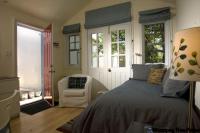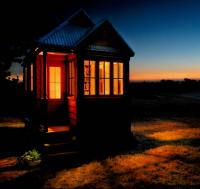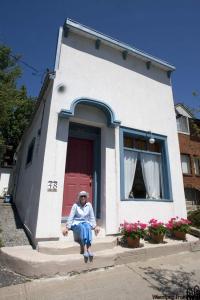And as long as I had room for my books and a place to sew.....
Living large ... in a small house

"I'm opposed to large homes. There's the environmental impact of extra energy for heating. It's a tremendous waste of space that people just walk through." Gail McEachern, Owner, 600-square-foot home in Ottawa
OTTAWA -- If small is the new normal in housing, as some experts suggest, a 120-year-old former barn in Ottawa is positively futuristic. Gail McEachern's house began life in the 1880s as a hay barn, morphed into a blacksmith's shop, turned into a corner store, and now serves as her home and office. Twelve feet wide, it totals just 600 square feet.
McEachern bought her tiny home in 2004. She subsequently converted the garage into a small bedroom-bathroom-kitchenette unit attached to the original home by a walkway, but the addition is used only by guests.
"I'm opposed to large homes," says McEachern, who owns Transitions in Living, which co-ordinates household moves for seniors. "There's the environmental impact of extra energy for heating. It's a tremendous waste of space that people just walk through."
What's more, bigger homes create a sense of isolation, she says, with owners having to create little pockets of cosiness they could have acquired by buying small in the first place. Besides, she adds, who needs all the extra housework that goes with a large home.
With an inevitable energy crunch coming down the pipe, soaring land costs and other factors in play, smaller homes -- though perhaps not quite as tiny as McEachern's -- loom large on the horizon, say many.
It's already happening with urban condos which are clocking in at as little as 300 square feet.
"Everyone's recalibrating," says Marianne Cusato. She's the Florida-based designer of the 1,771-square-foot, two-storey Home for the New Economy that made such a splash at the International Home Builders Show in Las Vegas earlier this year.
Someone who would have bought a 3,000-square-foot home is buying 2,400; people who would have bought 2,400 are going for 1,600 or 1,700.
Statistics seem to agree.
In the U.S., according to the National Association of Home Builders, the average size of a new home in 1978 was 1,750 square feet. By 2008, that had mushroomed to 2,520 square feet. Then, last year, for the first time since 1982, the size fell to 2,480 square feet, although the collapse of the country's housing market did make 2009 an unusual year.
U.S. builders, however, say they plan to focus on smaller homes this year. Canada does not collect such statistics, but where the elephant leads, we often follow.
Cusato sells plans for her Home for the New Economy for $750 at www.NewEconomyHome.com. She's also had so much success with the Katrina Cottage -- the low-cost, 350-square-foot midget originally designed for victims of hurricane Katrina -- that she's currently working up a slightly larger version for colder climates.
According to Cusato, ever-bigger homes, appealing for their airiness and light, were a reaction to the often-dark ranch homes and boxy split-levels of the 1950s and 60s. However, low energy costs, cheap land and a perverse hunger to keep up with Joneses meant that, before you could say Topsy, homes were becoming unwieldy castles in far-flung communities. The only way to differentiate McMansions, she says, is by adding on more.
"The cold-water shower of the 2008 financial meltdown, coupled with growing concern about the end of cheap oil for both heating and commuting, mean that's all changing," Cusato says.
She thinks the 1,200- and 1,300-square-foot homes most of us grew up in the 1950s could make a comeback. You take the massing of those 1950s houses and rearrange it to add modern kitchens and bathrooms and closets -- and yes, it could work.
But shrink too fast, says John Herbert, executive director of the Greater Ottawa Home Builders Association, and there'd probably be a revolt by the population before you ever hit 1,200 square feet.
Despite that, he sees smaller homes on the horizon.
"We've been talking about this for 20 years, but I believe we've reached the point where we'll see it start to happen within a year or two."
Among other reasons, he cites rising interest rates, the curtailment of urban sprawl in cities and a new emphasis among buyers on quality finishes rather than simple square footage.
John Kenward, chief operating officer of the Canadian Home Builders Association, points out everything from demographics to regional variances in land availability will influence house sizes.
"Is there a market for smaller homes? Yes. But it's not as though we've got some sort of golden rule that says all homes are getting smaller," he says.
Small bungalows in the 1,200-square-foot range, often aimed mostly at the singles market, are starting to crop up in cities across Canada, but these seem like behemoths next to dwellings from Tumbleweed Tiny House Company in the California community of Boyes Hot Springs.
Available either in plan or completed form, and ranging from 65 to 837 square feet, they can be seen at www.tumbleweedhouses.com. The smallest are on wheels, making them more like trailers, and feature two-burner stoves, a bar fridge and a loft bedroom accessible by ladder.
Costing anywhere from about $35 to $200 per square foot, these and other very small homes are still a niche market. The Small House Society (www.resourcesforlife.com/small-house-society) will bring you up to speed with a newsletter, links to books and other resources.
While you're browsing, have a look at www.thelittlehouse.ca. The website is dedicated to Toronto's smallest house, a 312-square-foot shrimp built in 1912. Newly renovated and energy-efficient, the media darling is still inhabited.
American architect Sarah Susanka is generally credited as a pioneer in the smaller-home movement. Author of the immensely popular series Not So Big Homes, Susanka advocates trimming one-third from the size and spending the extra money on quality finishes. Like others, she says the housing industry has been slow to respond to the economic meltdown, but is finally getting the message that small has gone mainstream.
-- Postmedia News

















